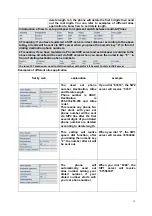
46
Field name
explanation
In_access enable
Select it to Enable in_ access rule
out_access enable
Select it to Enable out_ access rule
Input/Output
Specify current adding rule by selecting input rule or output rule.
Deny/Permit
Specify current adding rule by selecting Deny rule or Permit rule.
Protocol Type
Filter protocol type. You can select TCP, UDP, ICMP, or IP.
Port Range
Set the filter Port
range
Src Addr
Set source address. It can be single IP address, network address,
complete address 0.0.0.0, or network address similar to *.*.*.0
Des Addr
Set the destination address. It can be IP address, network address,
complete address 0.0.0.0, or network address similar to *.*.*.*
Src Mask
Set the
source address’ mask. For example, 255.255.255.255 means
just point to one host; 255.255.255.0 means point to a network
which network ID is C type.
Des Mask
Set the
destination address’ mask. For example, 255.255.255.255
means just point to one host; 255.255.255.0 means point to a
network which network ID is C type.
Click the Add button if you want to add a new output rule.
Then enable out_access, and click the Apply button.
So when devices execute to ping 192.168.1.118, system will deny the request to send icmp
request to 192.168.1.118 for the out_access rule. But if devices ping other devices which
network ID is 192.168.1.0, it will be normal.
Click the Delete button to delete the selected rule.
4.3.6.3. NAT Config
NAT is abbreviated from Net Address Translation; it’s a protocol responsible for IP address
translation. In other word, it is responsible for transforming IP and port of private network to
public, also is the IP address mapping which we usually say.








































